
A triglyceride, like cholesterol, is another lipid (fat or fat-like substance) that has been linked to heart disease.
An elevated level of triglycerides in the blood is an independent risk factor for having an increased risk of death by heart attack (Carlson and Bottiger, 1985).
Hopkins et al. (2005) also found that the association between the total triglyceride level in the blood and premature familial coronary atherosclerosis “is strong, graded, and independent.”
Mennander et al. (2005) further found that an elevated triglyceride level is significant in predicting the need for repeat coronary artery bypass surgeries in the future.
Kolovou et al. (2005) showed that patients with coronary artery atherosclerosis elevate their plasma triglyceride levels after a fatty meal higher than in patients without pre existing atherosclerosis.
Vitamin C dose dependent studies show 2,000 mg Vitamin C daily lowers triglycerides where 500 mg does not.
Vitamin C appears to positively affect triglyceride levels.
Erden et al. (1985) found that 2,000 mg of Vitamin C daily administered to a group of 50 volunteers over a two-month period decreased both the triglyceride and cholesterol levels, while increasing the HDL cholesterol fraction.
Please Note: Not surprisingly, the dose of Vitamin C appears to be critical in order to demonstrate this triglyceride-lowering effect.
Bishop et al. (1985) did a similar study in diabetic patients. However, only 500 mg of Vitamin C was given daily. Over a four-month period, no significant differences were seen in either the triglyceride or cholesterol levels.
It is also possible that another reason for some of the mixed results seemingly reported in the literature on the effects of Vitamin C on elevated triglyceride levels comes from the population of the patients being studied.
Wahlberg and WaJldjus (1982) reported that 2,000 mg of Vitamin C daily did not lower the serum triglycerides in the nine patients they treated. However, these patients all had an inherited disease characterized by elevated blood levels of triglycerides. Clearly, such a genetic disease can be expected to likely utilize different or additional mechanisms in the production of elevated triglycerides in the blood. Such a result cannot be used to generally dismiss the conclusions of studies that report the ability of Vitamin C to lower triglycerides in either normal patients or patients with other selected diseases.
Ness et al. (1996a) looked at the relationship of plasma Vitamin C level to the serum triglyceride level.
They concluded that the plasma Vitamin C level was negatively correlated with the triglyceride level, meaning the higher the Vitamin C level, the lower the triglyceride level. They also concluded that their results were consistent with other published work that indicated that a high dietary intake of Vitamin C not only lowered triglyceride levels, but also raised HDL cholesterol levels.
The effect of a combined antioxidant therapy on elevated serum triglyceride levels has also been studied.
Hamilton et al. (2000) found that a combination of only 500 mg of Vitamin C daily with a dosage of Vitamin E was effective in lowering both triglyceride and total cholesterol levels. Using a similarly dosed combination of Vitamins C and E, Babu et al. (2000) were also able to demonstrate the significant lowering of triglyceride levels that were elevated by the administration of Tamoxifen. Tamoxifen is a non-steroidal antiestrogen drug used in the hormonal treatment of breast cancer. These authors suggested that addition of Vitamins C and E to tamoxifen therapy was a superior form of treatment to tamoxifen alone.
In guinea pigs, Ha et al. (1990) also found that Vitamin C had a relationship to the blood level of triglycerides. By feeding four groups of animals varying amounts of Vitamin C, they were able to conclude that an inverse relationship existed between tissue levels of Vitamin C and plasma levels of triglycerides. As in the studies already noted above, higher amounts of Vitamin C were associated with lower amounts of triglycerides. These authors went so far as to suggest that Vitamin C deficiency in guinea pigs may impair the metabolism, or breakdown, of triglycerides in the blood.
Bobek et al. (1980), also studying guinea pigs, found that a “chronic borderline Vitamin C deficiency” led to both elevated blood levels of triglycerides as well as the accumulation of triglycerides in the liver.
It would appear, then, that elevated levels of triglycerides in the blood are best supported by a state of Vitamin C deficiency, along with inadequate dietary intake and supplementation of Vitamin C. When an elevated level of triglycerides is present in the blood, exerting its effect as a risk factor for the development of atherosclerosis, a Vitamin C deficiency can be expected to be present as well.
It’s quite evident, an excess presence of the fatty triglycerides works in concert with the Vitamin C deficiency to both initiate and accelerate the development of atherosclerosis. It’s likely that any future clinical studies using substantially higher supplemented doses of Vitamin C (for example, 5,000 to 15,000 mg daily) will consistently have a lowering effect on triglyceride levels from this supplementation.


